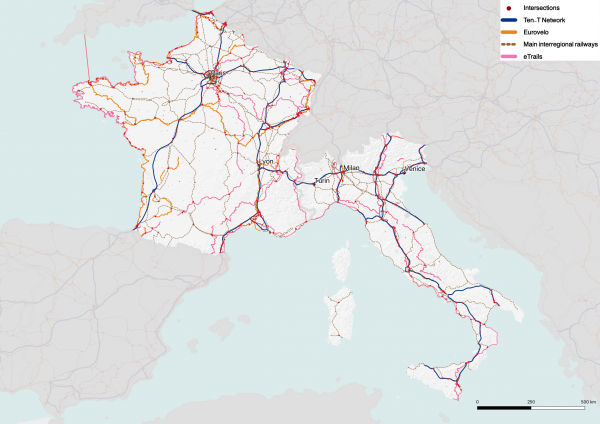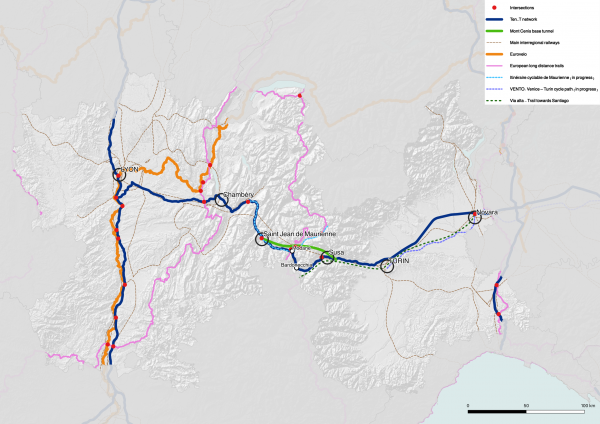A statement by TELT and Demos Helsinki for the Mediterranean Corridor of the TENT-T network Upon our imminent return to a world connected through travel, we have to face the challenge of respecting the environment while also supporting the transport industry. TELT, the French-Italian public promoter of the cross-border section…
A statement by TELT and Demos Helsinki for the Mediterranean Corridor of the TENT-T network
Upon our imminent return to a world connected through travel, we have to face the challenge of respecting the environment while also supporting the transport industry. TELT, the French-Italian public promoter of the cross-border section of the freight and passenger railway line Lyon-Turin, joined forces with Demos Helsinki to propose a regenerative interpretation of public transportation infrastructure to reconnect regions across scales. The vision reimagines the European map as a cross-border network that encourages and enables multimodal transport while respecting the environment and enabling local economies to flourish.
In this narrative, the Turin to Lyon turns into the first high-speed cross-border multimodal rail connecting Europe. It brings together the TEN-T network, national and regional railways, the Eurovelo (cycling network), and the long-distance trails.
TELT and Demos Helsinki share a commitment to developing an approach that puts people first. The key strategic objectives of this ideation were to (1) support the region’s decarbonisation goals and promote green growth while also (2) ensuring a just transition for the communities and the travel industry alike.
1. Supporting decarbonisation goals through encouraging green economic growth and enabling sustainable multimodal transport
For travel to become sustainable, enough accessible and attractive non-flight options should be available within reach. TELT is already making a positive impact by offering those non-flight options and thus lowering CO2 emissions along the Alps. To further leverage our commitment to decarbonisation goals, the narrative we have proposed provides a remarkable opportunity to make the Alps a sustainable and regenerative destination. As tourist preferences turn to sustainable locations, this new branding strategy makes the region appealing to new stakeholders. As a result, localities who benefit from the influx of newcomers will find the motivation to invest in circular economic assets.
To fully explore the transformational potential of travel, one has to also consider the role of multimodality. Our vision is to have an integrated mobility service for at least the primary modes (Rail, local public transit, bicycles, Pedestrians) to come together and generate a seamless human experience, door-to-door, from your home to the mountains and beyond. Furthermore, we have considered three key factors: (a) Multimodality replaces single-user-vehicles, so transmodal solutions could be a big, centralised step towards decarbonisation. (b) This approach helps speed the process to reach our climate goals, as consumer transition to electric vehicles is a slower process. (c) Large-scale infrastructure makes for a much more powerful and collective statement, so it has the potential to transform behaviour.
2. Committing to a just transition for travel while also empowering regional connectivity and identity
As, region-by-region, the EU is committing to decarbonise its industries, there will arise a need for an exemplary project to lead the path towards a just transition from fossil fuels. With this narrative, TELT will be a crucial player in this story, as jobs in the industry will transform during the transition from carbon. The new infrastructure will contribute a just redistribution of labour across new sectors of the economy—from the industry itself to the Alps as a whole.
TELT will expand its agency from an engineering endeavour to a platform for socially and economically relevant projects that will contribute to decarbonising regional travel routes.
When infrastructures connect small localities in cross-regional networks, it allows for a more equitable distribution of resources via tourism and access to regional markets. New opportunities open up for leisure and tourism, as transport facilitates fresh and unexpected links for the locals and visitors alike. This connection enables a vivid cultural exchange that can create hubs where tourists, travellers, and residents can meet and share goods, services, and resources. This way, the region will decrease its dependence on major intercontinental hubs and will transform into a unique market that adds value to the lives of its communities. As interactions flourish, so do the opportunities for equality as the areas around the links find it easier to keep up with their neighbours.
A Question of Scales
Mobility infrastructures for passengers and logistics are both ambitious engineering projects, and they model the development and lifestyles of local communities. They also represent one of the most tangible aspects of national political economies that can write the fate of entire regions. European infrastructures are promoted and financed for the common good and to increase the capacity to move sustainably across regions, link labour markets, grant fast access to the resources of the union and, of course, facilitate intercultural exchange. The TEN-T network is the backbone of the Union, with almost 300,000 km of railway lines, roads, waterways and maritime routes supported by ports, airports, and railway terminals. The second largest route is Mediterranean Corridor, connecting Eastern and Western Europe with 3,000 km of rail. The Lyon-Turin is included in this European political vision with 300 km of high-speed rail that will be central to provide a fast connection between Eastern and Western Europe. Once complete, the Lyon-Turin will become part of this European vision of regenerating local economies through mobility planning.

Alpine territories constitute an invaluable resource—not only for the 7 countries that host them but for the whole continent. But, unfortunately, today, these highlands are suffering both from the effects of climate change and from economic and social phenomena that are likely to cause impoverishment and shrinkage.

Protecting, and at the same time enhancing, the Alpine areas means implementing long-term solutions able to exploit technological, energetic, and economic innovations to the maximum so that we find a dynamic balance between humans and nature. Alpine valleys have been for thousands of years an obstacle and, at the same time, a point of contact between different cultures, economies, and political systems. Today, these territories face the challenge of finding ways to recover a 50-year-long inattention. The regenerative infrastructures are the key to achieving the goal of integration with other areas of the continent: metropolitan cities, industrial or cultural production poles.

Mixed and evolved railways, cycle paths, and long-distance trekking routes are the three sides of a triangle that draw the mountain of the future: connected but free from the grip of road logistics and seasonal tourism that crowd places for a few weeks but abandon them the rest of the year.
Conclusions
Smart Lands are territories that transform their environmental, social, and economic fragility by overturning the paradigms of growth (or degrowth): it is not a question of slowing down or accelerating, increasing or decreasing, but creating regular, lasting flows compatible with environmental and economic resources. TELT has a new narrative of a project capable of regenerating local economies after the pandemic in respect of local identities and cultural heritage. Stations will be the node for all zero-emission mobility services provided locally, and it will offer a unique journey experience. It will allow transnational commuting, riding a bicycle, opening a path to carbon neutral tours and make rail the favourite choice over regional flights to provide a sustainable and regenerative future.
For more information contact: Damiano Cerrone, damiano.cerrone@demoshelsinki.fi
Featured image: Lara Jameson / Pexels

21st-century infrastructure must be regenerative
Post
July 25, 2022
Infrastructure: The overlooked tool for societal transformation
Post
July 25, 2022
What is regenerative infrastructure?
Post
July 25, 2022
Five statements for sustainable urban mobility — learnings from Finland
Post
December 22, 2021